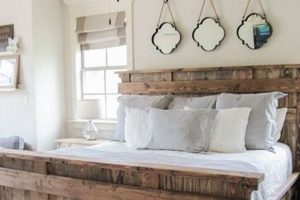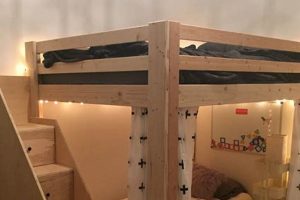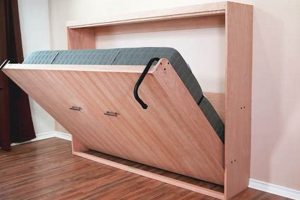The construction of sleeping platforms using readily available materials and individual craftsmanship represents an accessible avenue for creating personalized furniture. These elevated bed frames are often characterized by their minimalist design, offering a solid, supportive base without the need for a box spring. Examples include frames constructed from reclaimed wood, repurposed pallets, or assembled lumber, each reflecting the builder’s specific aesthetic preferences and spatial requirements.
These structures offer several advantages, including cost savings compared to purchasing pre-fabricated alternatives. The design facilitates customization regarding height, size, and integrated features such as storage compartments or headboards. Historically, similar elevated sleeping surfaces have been prevalent in various cultures, evolving from simple raised platforms to more sophisticated designs incorporating functionality and decorative elements. This approach provides a durable and adaptable sleeping solution.
The subsequent sections will explore diverse construction techniques, material selection considerations, and design variations applicable to crafting a personalized sleeping platform. It will delve into essential tools, safety precautions, and step-by-step instructions to guide the process of building a stable and aesthetically pleasing sleeping structure.
Essential Considerations for Platform Bed Construction
The following guidelines are intended to enhance the structural integrity, aesthetic appeal, and longevity of a self-constructed sleeping platform.
Tip 1: Material Selection is Paramount. Opt for hardwoods such as oak or maple for primary structural components due to their superior strength and resistance to deformation. Softwoods, like pine, may be suitable for non-load-bearing elements, but require careful fastening and potentially more frequent maintenance.
Tip 2: Prioritize Accurate Measurements. Precise measurements of the intended mattress and the available space are crucial. Deviations from accurate dimensions can result in an unstable or ill-fitting structure, compromising both comfort and safety.
Tip 3: Employ Robust Joinery Techniques. Mortise and tenon joints, dovetail joints, or reinforced screw connections significantly enhance the frame’s stability. Avoid relying solely on nails or staples for load-bearing connections.
Tip 4: Reinforce the Central Support. For larger bed sizes (queen or king), a central support beam is essential to prevent sagging. This beam should be adequately sized and properly attached to the side rails to distribute weight evenly.
Tip 5: Ensure a Level Surface. Verify that the platform is perfectly level using a spirit level. Adjust leg heights as necessary to compensate for uneven flooring, ensuring balanced weight distribution and preventing rocking.
Tip 6: Address Sharp Edges and Corners. Thoroughly sand all edges and corners to prevent injury. Consider applying edge banding or rounded trim for added safety and aesthetic refinement.
Tip 7: Apply a Protective Finish. A durable finish, such as polyurethane or varnish, protects the wood from moisture, scratches, and UV damage, extending the platform’s lifespan. Ensure proper ventilation during application and allow adequate drying time.
Adhering to these guidelines promotes the creation of a structurally sound, visually appealing, and durable sleeping platform, maximizing both comfort and value.
The subsequent section will explore advanced design considerations and potential modifications to further personalize the constructed sleeping platform.
1. Frame Dimensions
Frame dimensions constitute a foundational element in the domain of self-constructed sleeping platforms. Precise calculations are essential for ensuring compatibility with standard mattress sizes, optimizing spatial utilization within the designated environment, and preventing structural instabilities. Deviations from established parameters can result in compromised functionality and diminished aesthetic appeal.
- Mattress Compatibility
Accurate frame dimensions directly influence the seamless integration of a mattress. Standard mattress sizes (Twin, Full, Queen, King) dictate the internal measurements of the platform frame. A frame that is undersized will not accommodate the mattress, while an oversized frame will result in unsightly gaps and potential shifting. Precision is therefore paramount.
- Spatial Optimization
External frame dimensions must be carefully considered in relation to the room’s available area. Overly large platforms can obstruct movement and diminish the room’s functionality. Conversely, excessively small platforms may fail to maximize available space or provide adequate sleeping surface. A balanced approach, accounting for both mattress size and room dimensions, is critical.
- Structural Integrity
Frame dimensions have a direct impact on structural requirements. Larger platforms necessitate more robust support systems to prevent sagging and ensure stability. The spacing and dimensions of support beams, side rails, and legs are all influenced by the overall frame size. Failure to adequately reinforce larger platforms can lead to premature failure.
- Design Aesthetics
Frame dimensions contribute significantly to the overall aesthetic appeal of the platform. Proportions, height, and overall shape are all dictated by the frame’s measurements. These dimensions must be carefully considered in relation to the room’s existing decor and the desired style (e.g., minimalist, rustic, modern) to create a cohesive and visually pleasing result.
The aforementioned facets illustrate the critical role of frame dimensions in the design and execution of handcrafted sleeping platforms. Mastering precise measurement and dimension calculation facilitates the creation of a functional, structurally sound, and aesthetically harmonious sleeping environment. Neglecting these considerations can compromise the project’s outcome, leading to dissatisfaction and potential structural issues. Proper execution is paramount.
2. Material Durability
Material durability represents a critical factor in the construction of self-assembled sleeping platforms. The selection of appropriate materials directly influences the lifespan, stability, and overall value of the finished product. The inherent properties of chosen materials determine the platform’s resistance to stress, wear, and environmental factors. This aspect requires careful consideration to ensure a long-lasting and safe structure.
- Load-Bearing Capacity
The selected material’s inherent strength dictates the maximum weight the platform can support without deformation or failure. Hardwoods, such as oak or maple, possess superior load-bearing capabilities compared to softwoods like pine. This capacity is crucial for accommodating mattresses and occupants without compromising structural integrity. Insufficient load-bearing capacity can lead to sagging, cracking, or complete collapse of the platform.
- Resistance to Wear and Tear
The platform’s surface is subject to friction from mattress movement and regular use. Durable materials, such as those with a high density and abrasion resistance, withstand this wear more effectively. Protective finishes, like polyurethane or varnish, enhance this resistance further. The absence of sufficient resistance results in surface scratches, dents, and premature degradation of the material’s appearance.
- Environmental Resistance
Exposure to fluctuations in humidity and temperature can cause dimensional changes in certain materials. Materials with low moisture absorption and high dimensional stability, such as kiln-dried hardwoods or treated lumber, are preferable. This characteristic prevents warping, cracking, and loosening of joints. Inadequate environmental resistance compromises the platform’s long-term structural integrity.
- Fastener Retention
The ability of the material to securely hold fasteners, such as screws or nails, is essential for maintaining the platform’s structural integrity. Dense materials with a tight grain structure provide better fastener retention. Proper pre-drilling techniques and appropriate fastener selection also contribute to this aspect. Poor fastener retention can lead to loosening of joints, instability, and eventual failure of the platform.
The interplay of these facets underscores the paramount importance of material durability in the successful construction of a handcrafted sleeping platform. The careful selection of materials with appropriate load-bearing capacity, wear resistance, environmental stability, and fastener retention properties ensures the creation of a safe, functional, and aesthetically pleasing structure that can withstand the rigors of daily use over an extended period. In contrast, a lack of attention to these aspects results in a compromised structure that may require frequent repairs or premature replacement.
3. Joint Strength
Joint strength represents a critical determinant of the structural integrity and longevity of self-constructed sleeping platforms. The capacity of the connections between individual components to withstand stress and maintain structural cohesion directly influences the platform’s stability, safety, and overall performance. Insufficient joint strength compromises the entire assembly, potentially leading to failure under load.
- Load Distribution
Robust joints effectively distribute weight across the entire frame, preventing localized stress concentrations that can lead to failure. Techniques such as mortise and tenon, dovetail, or well-executed screw joinery, coupled with appropriate adhesive application, ensure that load is transferred evenly between connected members. Conversely, weak joints, relying solely on nails or insufficient adhesive, create weak points prone to deformation or breakage under stress.
- Resistance to Racking Forces
Sleeping platforms are subject to racking forces stresses that attempt to distort the frame laterally. Strong, rigid joints resist these forces, maintaining the platform’s squareness and preventing instability. Diagonal bracing, incorporated into the frame design, further enhances resistance to racking. The absence of adequate joint strength and bracing leads to a wobbly and potentially unsafe structure that is susceptible to collapse under lateral stress.
- Prevention of Joint Separation
The cyclical loading and unloading of a sleeping platform can cause joints to loosen over time. Well-constructed joints, utilizing mechanical interlocking and robust fastening methods, resist this tendency. The use of high-quality fasteners and appropriate joint preparation techniques minimizes the risk of separation. Inadequate joint construction results in creaking, loosening, and eventual failure of the connection, compromising the platform’s stability and safety.
- Long-Term Stability
The long-term stability of a sleeping platform is directly proportional to the strength and durability of its joints. Properly executed joints, using appropriate materials and construction techniques, maintain their integrity over extended periods, ensuring consistent performance. Conversely, weak joints degrade over time, leading to a gradual decline in structural integrity and a shortened lifespan for the platform. The initial investment in robust joint construction pays dividends in terms of long-term reliability and safety.
The foregoing underscores the critical link between joint strength and the overall performance of handcrafted sleeping platforms. A commitment to utilizing appropriate joint construction techniques and high-quality materials ensures the creation of a safe, stable, and long-lasting sleeping structure. Neglecting this crucial aspect compromises the entire project, potentially leading to premature failure and safety hazards.
4. Support Structure
The support structure within a self-assembled sleeping platform constitutes the foundational framework upon which stability, weight distribution, and overall structural integrity are contingent. Its proper design and execution are paramount for ensuring a safe and functional sleeping surface. Inadequate support leads to sagging, instability, and potential structural failure, compromising both comfort and safety.
- Central Load-Bearing Beams
Central beams, typically oriented lengthwise, are essential for distributing the load across the platform’s span, particularly in larger bed sizes such as Queen or King. These beams, constructed from hardwoods like oak or maple, prevent sagging and ensure even weight distribution. Their size and placement are determined by the span and anticipated load. An insufficient central beam results in noticeable sagging and potential structural damage over time.
- Side Rails and Perimeter Framing
Side rails and the surrounding perimeter frame provide lateral stability and support the outer edges of the platform. These components are typically constructed from lumber of sufficient thickness and strength to resist bending and twisting. Secure attachment to the legs and central support beams is critical for maintaining structural integrity. Weak or poorly attached side rails compromise the platform’s stability and contribute to uneven weight distribution.
- Leg Placement and Distribution
The strategic placement and distribution of legs are vital for evenly distributing the platform’s weight across the floor. Legs should be located at the corners and along the central span to provide maximum support. The number and size of legs are determined by the platform’s overall dimensions and anticipated load. Uneven leg distribution or insufficient leg support leads to instability and potential damage to the flooring.
- Internal Support Slats or Decking
Internal support slats or decking provide a continuous surface for the mattress to rest upon. These components distribute weight evenly across the support structure, preventing localized stress concentrations. Slats are typically spaced at regular intervals, while decking provides a solid, continuous surface. Inadequate internal support leads to uneven mattress wear and potential damage to the underlying structure.
In summation, the support structure forms the bedrock of a durable and functional self-assembled sleeping platform. The appropriate selection of materials, careful attention to design principles, and meticulous execution of construction techniques are all essential for creating a stable, safe, and long-lasting sleeping surface. Neglecting these considerations inevitably leads to a compromised structure with diminished performance and a shortened lifespan.
5. Surface Finishing
Surface finishing represents a critical and often underestimated stage in the construction of self-assembled sleeping platforms. This process extends beyond mere aesthetics; it directly impacts the longevity, durability, and safety of the finished structure. Appropriate surface treatments provide protection against environmental factors, enhance resistance to wear and tear, and contribute to the overall visual appeal.
- Protection Against Moisture Intrusion
Unfinished wood is susceptible to moisture absorption, leading to warping, cracking, and eventual decay. Sealants, varnishes, and oil-based finishes create a barrier against moisture, preventing water from penetrating the wood’s cellular structure. In coastal regions or environments with high humidity, this protection is especially critical. For instance, a platform constructed from reclaimed wood should be thoroughly sealed to prevent the reactivation of any existing moisture damage and mitigate future deterioration.
- Enhancement of Wear Resistance
Sleeping platforms are subjected to constant friction from mattresses and occupants. Surface finishes such as polyurethane provide a durable, abrasion-resistant layer that protects the underlying wood from scratches, dents, and general wear. This is particularly relevant in high-traffic areas or for platforms used by individuals with pets. Consider the difference between a platform finished with a single coat of wax versus one coated with multiple layers of polyurethane; the latter will exhibit significantly greater resistance to daily wear and tear.
- Mitigation of Allergenic Potential
Certain wood species contain natural oils and resins that can trigger allergic reactions in sensitive individuals. Surface finishes encapsulate these substances, preventing them from being released into the surrounding environment. This is particularly important when using aromatic woods like cedar or pine. For example, a person with known wood allergies could significantly reduce their risk of reaction by ensuring that the platform is sealed with a non-toxic, hypoallergenic finish.
- Contribution to Aesthetic Appeal and Cleanability
Surface finishes enhance the wood’s natural beauty, highlighting grain patterns and adding depth of color. They also create a smooth, easily cleanable surface that resists stains and spills. Different finishes provide varying levels of sheen and visual texture, allowing for customization to match individual preferences. A platform finished with a matte lacquer offers a subtle, understated look, while a high-gloss polyurethane provides a more dramatic and reflective surface. Furthermore, a sealed surface simplifies routine cleaning, preventing the accumulation of dust and allergens.
The application of appropriate surface finishes transcends mere cosmetic enhancement in the context of self-assembled sleeping platforms. It serves as a critical layer of protection, bolstering the structure’s durability, mitigating potential health risks, and ultimately extending its lifespan. The careful selection and application of suitable finishes are integral to ensuring the creation of a safe, aesthetically pleasing, and long-lasting sleeping environment.
Frequently Asked Questions Regarding Self-Assembled Sleeping Platforms
The following section addresses common inquiries and misconceptions pertaining to the design, construction, and maintenance of handcrafted sleeping platforms. The objective is to provide clarity and guidance to individuals contemplating or engaged in such projects.
Question 1: What is the minimum recommended material thickness for constructing a structurally sound platform bed?
The minimum recommended material thickness for load-bearing components, such as side rails and support beams, is 1.5 inches if utilizing hardwoods such as oak or maple. For softwoods like pine, a thickness of at least 2 inches is advisable to ensure adequate structural integrity.
Question 2: How can one effectively mitigate squeaking in a newly constructed platform bed?
Squeaking often arises from friction between wood components. Applying felt pads between contacting surfaces, lubricating joints with beeswax or paraffin, and ensuring tight, secure fastening can effectively reduce or eliminate such noises.
Question 3: What are the essential safety precautions to observe during the construction process?
Essential safety precautions include wearing appropriate personal protective equipment (safety glasses, gloves, dust mask), utilizing power tools in accordance with manufacturer instructions, ensuring adequate ventilation when applying finishes, and maintaining a clean and organized workspace.
Question 4: Is it necessary to incorporate a box spring with a platform bed, or can a mattress be placed directly on the platform?
A box spring is generally not necessary with a platform bed, as the platform provides sufficient support for the mattress. However, some individuals may prefer the added height and support provided by a box spring. The decision is largely a matter of personal preference.
Question 5: How can one effectively integrate storage solutions into a platform bed design?
Storage solutions can be integrated by incorporating drawers into the frame, creating open shelving beneath the platform, or designing a hinged platform that lifts to reveal storage space within the frame. Careful planning and precise execution are essential for maximizing storage capacity and maintaining structural integrity.
Question 6: What are the best practices for cleaning and maintaining a platform bed to ensure its longevity?
Best practices include regularly dusting the frame, cleaning spills promptly with a damp cloth, and applying a protective finish to the wood surface. Periodic inspection of joints and fasteners is also recommended to identify and address any signs of loosening or damage.
Adhering to these guidelines promotes the creation of a structurally sound, visually appealing, and durable sleeping platform, maximizing both comfort and value.
The subsequent section will explore advanced design considerations and potential modifications to further personalize the constructed sleeping platform.
Conclusion
This discourse has presented a comprehensive overview of considerations pertinent to the construction of self-assembled sleeping platforms. Emphasis has been placed on material selection, dimensional accuracy, joint strength, support structure, and surface finishing as critical determinants of structural integrity, longevity, and overall value. Further, frequently encountered inquiries and recommended practices have been addressed to provide clarity and guidance throughout the construction process. The effective application of these principles serves to facilitate the creation of durable and functional sleeping platforms tailored to individual needs and spatial constraints.
The informed execution of a sleeping platform project necessitates diligent planning and adherence to established construction standards. While the prospect of crafting personalized furniture offers inherent advantages, neglecting fundamental principles can compromise structural integrity and safety. Individuals embarking on this endeavor are encouraged to prioritize thorough research and meticulous craftsmanship, thereby ensuring a structurally sound and aesthetically pleasing outcome that provides long-term utility and value.







